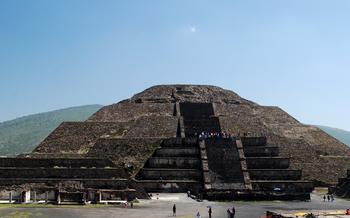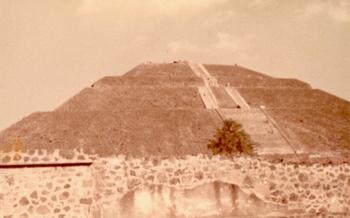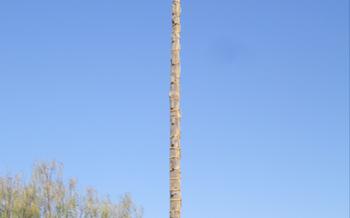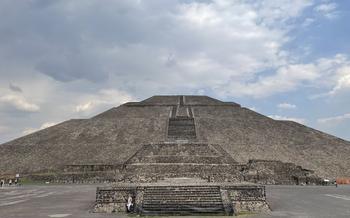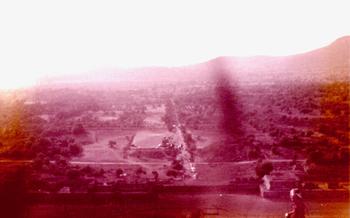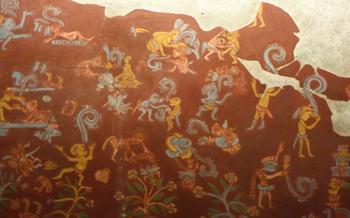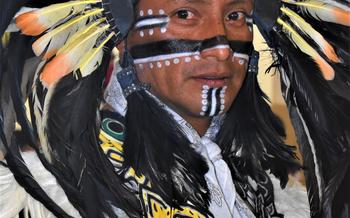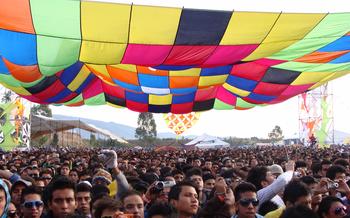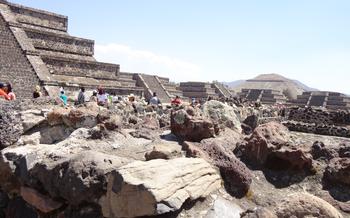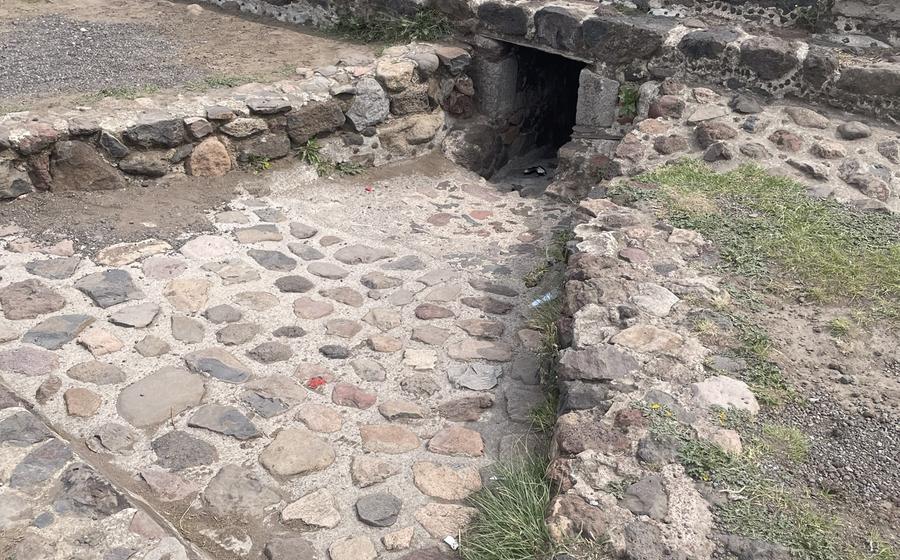
Avenue of the Dead
- The Avenue of the Dead: A Brief History
- Pyramids of the Sun and the Moon: Architectural Wonders
- Temple of Quetzalcoatl: A Masterpiece of Art
- Distinctive Architectural Elements
- Symbolism and Iconography
- Restoration and Preservation Efforts
- The Street of the Dead: A Vibrant Marketplace
- Museo de Sitio de Teotihuacan: Uncovering the Past
- Sunrise at the Pyramids: A Magical Experience
- Hot Air Balloon Ride: A Bird's-Eye View
- Nighttime Light Show: A Multimedia Spectacle
- Guided Tours: Enriching Your Experience
- Local Cuisine: A Culinary Delight
- Photography Tips: Capturing the Beauty
- Safety Precautions: Ensuring a Smooth Visit
- Accessibility: Planning for All Visitors
- Insider Tip: Hidden Gems Off the Beaten Path
The Avenue of the Dead: A Brief History
The Avenue of the Dead, an awe-inspiring testament to ancient Mexican engineering and urban planning, is the heart and soul of the ancient city of Teotihuacan. This 5-mile-long (4 km) ceremonial road forms the central axis of the city, connecting the Temple of Quetzalcoatl in the north with the Pyramids of the Sun and the Moon in the south.
-
Historical Significance: The Avenue of the Dead played a pivotal role in Teotihuacan's religious, political, and social life. It served as a stage for grand processions and ceremonies, a marketplace for trade and exchange, and a symbol of the city's power and prestige.
-
Construction and Layout: The Avenue was meticulously planned and constructed, demonstrating the advanced architectural prowess of the Teotihuacans. Its straight, symmetrical layout is aligned with the cardinal points, mirroring the celestial order that the city's builders sought to emulate.
-
Cultural and Religious Importance: The Avenue was not just a thoroughfare but a sacred space, infused with religious significance. Temples, shrines, and residential compounds lined the avenue, creating a vibrant and diverse cityscape that reflected the complex social and religious hierarchy of Teotihuacan.
Pyramids of the Sun and the Moon: Architectural Wonders
The Avenue of the Dead is flanked by two awe-inspiring pyramids that stand as testaments to the architectural prowess of the Teotihuacan civilization: the Pyramid of the Sun and the Pyramid of the Moon. The Pyramid of the Sun, the largest structure in the city, rises to a height of 75 meters (246 feet) and has a massive base of 225 meters (738 feet) on each side. It is believed to have been constructed in the 2nd century AD and served as a temple dedicated to the sun god Tonatiuh.
The Pyramid of the Moon, though smaller in size, is no less impressive. Standing at 45 meters (148 feet) tall, with a base of 150 meters (492 feet) on each side, it was constructed around the same time as the Pyramid of the Sun. The pyramid was dedicated to the moon goddess Coyolxauhqui, and its interior contains a series of murals and sculptures depicting the goddess and her story.
The construction of these pyramids involved meticulous planning, engineering skills, and a vast labor force. The Teotihuacans used locally sourced materials, primarily adobe bricks and volcanic rock. They employed a unique construction technique called talud-tablero, which involved building sloping walls with alternating layers of stone and adobe. This technique provided stability and strength to the structures, allowing them to withstand the test of time.
The pyramids also demonstrate a sophisticated understanding of astronomy. They were carefully aligned with the cardinal directions, and their orientation allowed for precise observations of celestial events. The Pyramid of the Sun, for example, is aligned with the sunset on the summer solstice, while the Pyramid of the Moon aligns with the moon's zenith passage. These alignments suggest that the pyramids served not only as religious structures but also as observatories for astronomical studies.
Temple of Quetzalcoatl: A Masterpiece of Art
The Temple of Quetzalcoatl, also known as the Temple of the Feathered Serpent, stands as a testament to the architectural prowess and artistic mastery of the Teotihuacan civilization. Dedicated to the revered deity Quetzalcoatl, the temple showcases unique features that set it apart from the other structures in the city.
Distinctive Architectural Elements
The temple's most striking feature is its undulating facade, adorned with intricate carvings depicting the feathered serpent deity. These carvings, rendered in vibrant colors and meticulous detail, create a mesmerizing visual effect that seems to bring the temple to life.
Flanking the temple's entrance are two large stone sculptures depicting the heads of Quetzalcoatl, complete with feathered headdresses and gaping mouths. These sculptures serve as guardians, symbolizing the deity's protective presence over the temple and its sacred precinct.
Symbolism and Iconography
The Temple of Quetzalcoatl is a rich repository of symbolism, with every element carrying profound religious and cultural significance. The feathered serpent deity, represented by the temple's facade and sculptures, symbolized fertility, water, and the wind, playing a crucial role in Teotihuacan's agricultural and spiritual beliefs.
The temple's interior walls are adorned with colorful murals depicting various scenes from Teotihuacan mythology. These murals showcase the intricate storytelling and artistic techniques of the Teotihuacan people, providing glimpses into their beliefs and rituals.
Restoration and Preservation Efforts
Over the centuries, the Temple of Quetzalcoatl has undergone extensive restoration and preservation efforts aimed at safeguarding its architectural integrity and cultural significance. Archaeologists and conservators have worked diligently to stabilize the structure, restore its original colors, and protect the delicate murals from further deterioration.
As a result of these efforts, the Temple of Quetzalcoatl remains one of the best-preserved structures in Teotihuacan, allowing visitors to appreciate its architectural beauty and cultural significance in all its glory.
The Street of the Dead: A Vibrant Marketplace
The Street of the Dead, also known as the Calzada de los Muertos, was once the main artery of the ancient city of Teotihuacan. Today, it is a bustling marketplace where visitors can immerse themselves in the vibrant energy of Mexican culture.
Strolling along the Calzada de los Muertos, you'll encounter a plethora of shops, stalls, and vendors selling an array of local crafts, souvenirs, and traditional Mexican goods. From intricate pottery and woven textiles to handmade jewelry and colorful trinkets, there's something for every taste and budget.
The atmosphere in the Calzada de los Muertos is electric, with the sounds of vendors hawking their wares, the smell of delicious street food wafting in the air, and the colorful sights of traditional Mexican clothing and crafts creating a feast for the senses.
But the Calzada de los Muertos is more than just a shopping destination; it's also a place to experience the local culture and way of life. Take the time to interact with the friendly vendors, learn about their crafts, and perhaps even haggle for a good price.
Whether you're looking for a unique souvenir to take home or simply want to soak up the vibrant atmosphere of Teotihuacan, the Calzada de los Muertos is a must-visit destination.
Museo de Sitio de Teotihuacan: Uncovering the Past
Step into the Museo de Sitio de Teotihuacan, a treasure trove of knowledge and artifacts that unveils the captivating story of this ancient city. Through interactive exhibits, you'll embark on a journey into the heart of Teotihuacan's culture, unraveling its mysteries and gaining a deeper understanding of its people.
Discover the remarkable archaeological discoveries that have shed light on Teotihuacan's past. From intricately carved sculptures to pottery adorned with vibrant colors, each artifact tells a tale of the city's artistry and craftsmanship. Immerse yourself in the interactive displays, where you can handle replicas of ancient tools, try your hand at hieroglyphic writing, and witness the meticulous process of archaeological excavations.
The museum's collection extends beyond artifacts, providing a comprehensive insight into Teotihuacan's social structure, religious beliefs, and daily life. Learn about the city's complex political system, the significance of its religious rituals, and the intricate urban planning that made Teotihuacan a marvel of engineering.
As you explore the Museo de Sitio de Teotihuacan, you'll gain a profound appreciation for the ingenuity and legacy of this ancient civilization. The museum serves as a gateway to understanding the enduring impact of Teotihuacan, leaving you with a lasting impression of its grandeur and significance.
Sunrise at the Pyramids: A Magical Experience
Watching the sunrise over the ancient pyramids of Teotihuacan is an awe-inspiring experience that should not be missed. As the first rays of light illuminate the majestic structures, the entire complex comes alive with an ethereal glow. The sky transforms into a canvas of vibrant colors, casting a warm radiance upon the pyramids and the surrounding landscape.
Whether you're a seasoned traveler or a first-time visitor, witnessing this spectacle is a truly magical moment. The pyramids, already impressive during the day, take on a new and breathtaking dimension as the sun rises. It's an experience that will leave you speechless and fill you with a sense of wonder and tranquility.
To make the most of your experience, plan your visit accordingly. Aim to arrive at the pyramids at least 30 minutes before sunrise to secure a good spot and enjoy the changing colors of the sky. Bring a blanket or a mat to sit on, as the ground can be chilly in the early morning. Also, pack a camera to capture the stunning views and the unique atmosphere of this special moment.
As the sun slowly rises above the horizon, you'll witness the pyramids bathed in a warm, golden light. The shadows cast by the structures create dramatic effects, highlighting the intricate details and grandeur of these ancient monuments. The atmosphere is serene and peaceful, with only the sounds of nature and the gentle breeze rustling through the trees.
The sunrise at Teotihuacan is not just a visual spectacle but also a spiritual and cultural experience. For the ancient Teotihuacanos, the sun held a sacred significance, and the pyramids were aligned to mark astronomical events, such as the summer and winter solstices. By witnessing the sunrise over these sacred structures, you'll gain a deeper appreciation for the beliefs and rituals of this ancient civilization.
Whether you're seeking a spiritual connection, a unique photo opportunity, or simply a breathtaking experience, sunrise at the pyramids of Teotihuacan is an unforgettable moment that will stay with you long after your visit.
Hot Air Balloon Ride: A Bird's-Eye View
Soaring above the ancient city of Teotihuacan in a hot air balloon is an experience that combines breathtaking views with a sense of awe and wonder. As you gently ascend into the sky, the sprawling complex of pyramids, temples, and plazas unfolds beneath you, revealing a perspective that is simply impossible to appreciate from the ground.
The panoramic vistas from a hot air balloon ride offer a unique opportunity to grasp the sheer scale and majesty of Teotihuacan. You'll have a bird's-eye view of the Avenue of the Dead, the Pyramids of the Sun and the Moon, and the surrounding landscape, dotted with smaller pyramids and temples. The intricate urban planning and symmetry of the city become even more apparent from above, providing a glimpse into the advanced civilization that once thrived here.
Safety is paramount during hot air balloon rides, and strict regulations are in place to ensure a smooth and enjoyable experience. Balloons are operated by experienced pilots who undergo rigorous training and adhere to strict safety protocols. Before takeoff, you'll be given a thorough safety briefing, and throughout the flight, the pilot will keep you informed of any changes in altitude or direction.
A hot air balloon ride over Teotihuacan is a once-in-a-lifetime opportunity to witness the grandeur of this ancient city from a truly unique perspective. It's an experience that will leave you with lasting memories and a profound appreciation for the ingenuity and artistry of the Teotihuacan people.
Nighttime Light Show: A Multimedia Spectacle
As the sun sets over Teotihuacan, the ancient city comes alive with a captivating nighttime light show. This immersive experience transforms the Avenue of the Dead into a vibrant canvas, where history and culture come to life through stunning visuals and enchanting music.
The show, titled "Teotihuacan: Night of the Gods," is a masterpiece of multimedia storytelling. It uses cutting-edge projection technology to illuminate the pyramids, temples, and other structures with vibrant colors, animations, and historical imagery. As the show progresses, visitors are transported back in time, experiencing the grandeur and mysticism of ancient Teotihuacan.
The light show is a must-see for anyone visiting Teotihuacan. It is a unique and unforgettable way to learn about the city's rich history and culture. The show is approximately 30 minutes long and is narrated in both Spanish and English. It is held every night of the week, with showtimes varying depending on the season.
To make the most of your experience, it is recommended to arrive at the Avenue of the Dead at least 30 minutes before the show starts. This will give you enough time to find a good viewing spot and soak in the atmosphere. You can also purchase souvenirs or snacks from the vendors who set up shop along the Avenue.
Remember to bring a camera to capture the stunning visuals of the show. However, it is important to note that tripods and selfie sticks are not allowed during the show. You should also dress comfortably, as you will be standing or sitting for approximately 30 minutes.
The Nighttime Light Show at Teotihuacan is a magical and unforgettable experience that should not be missed. It is a perfect way to end a day of exploring this ancient city and immerse yourself in its rich history and culture.
Guided Tours: Enriching Your Experience
Exploring the Avenue of the Dead and the surrounding archaeological zone with a guided tour is an excellent way to delve deeper into the history, culture, and significance of Teotihuacan. Professional guides offer expert insights and historical context, bringing the ancient city to life. They can point out hidden details, explain the symbolism and iconography of the pyramids and temples, and provide a comprehensive understanding of the site's significance.
Various types of guided tours are available to suit different interests and preferences. Private tours offer a personalized experience, allowing you to set your own pace and ask specific questions. Group tours are a more budget-friendly option and provide an opportunity to interact with other travelers. Some tours focus on specific aspects of Teotihuacan, such as its architecture, history, or spirituality. Whether you're a history buff, an archaeology enthusiast, or simply curious about ancient civilizations, a guided tour will enhance your visit to Teotihuacan.
Local Cuisine: A Culinary Delight
Indulge in the rich flavors of Mexican cuisine during your visit to Teotihuacan. The region offers a diverse culinary scene, from traditional dishes to street food delicacies.
-
Traditional Dishes: Savor the iconic barbacoa, a slow-cooked lamb or goat dish, typically served with tortillas and a spicy salsa.
-
Street Food: Don't miss the chance to try tacos al pastor, a popular street food consisting of spit-roasted pork, pineapple, and salsa, served on a corn tortilla.
-
Market Delicacies: Visit the local markets to sample fresh fruits, handmade tortillas, and traditional sweets like churros and buñuelos.
-
Recommended Restaurants: For a memorable dining experience, try La Gruta, a charming restaurant set in a cave, or La Casita de las Sirenas, known for its fresh seafood and stunning views of the pyramids.
Photography Tips: Capturing the Beauty
Golden Hour Magic: Plan your visit to coincide with the golden hours, just after sunrise and just before sunset, when the warm, diffused light casts a magical glow on the ancient structures, creating a photographer's dream.
Composition Techniques: Experiment with different angles and perspectives to create dynamic compositions. Capture the towering pyramids against the vast sky, or frame them through the surrounding foliage for a more intimate feel.
Camera Settings: Use a wide-angle lens to fit the awe-inspiring structures into your frame. Adjust your aperture to control the depth of field, blurring the foreground or background to draw attention to your focal point.
Tripod Stability: Bring a sturdy tripod to ensure sharp images, especially when shooting in low-light conditions. A tripod will also allow you to experiment with slower shutter speeds to capture the movement of clouds or people.
Filters and Effects: Enhance your photos with filters and post-processing techniques. Use a polarizing filter to reduce glare and saturate colors, or experiment with black-and-white conversions to create a timeless, dramatic effect.
Safety Precautions: Ensuring a Smooth Visit
Teotihuacan is generally considered a safe destination, but as with any tourist attraction, it's essential to exercise caution and be aware of your surroundings. Here are some safety tips to ensure a smooth and enjoyable visit:
- Be vigilant against petty theft: Keep your valuables close and avoid wearing flashy jewelry or carrying large amounts of cash.
- Beware of scams: Be wary of individuals offering unsolicited tours or services, especially outside the main entrance. Always confirm prices and services with authorized personnel.
- Respect local customs: Dress modestly and behave respectfully, particularly when visiting religious or sacred sites.
- Stay hydrated: The Mexican sun can be intense, so bring a hat, sunglasses, and plenty of water to stay hydrated.
- Protect yourself from the sun: Apply sunscreen regularly, especially during the midday hours.
- Be aware of your surroundings: Stay alert and avoid walking alone in isolated areas, especially at night.
- Learn a few basic Spanish phrases: This can be helpful for communicating with locals and asking for directions or assistance.
By following these safety tips, you can ensure a safe and enjoyable visit to Teotihuacan, allowing you to fully immerse yourself in the wonders of this ancient city.
Accessibility: Planning for All Visitors
Teotihuacan is committed to ensuring that all visitors, regardless of their abilities, can enjoy a safe and enriching experience. Wheelchair accessibility is a priority, with designated ramps, elevators, and accessible restrooms throughout the site. Visitors with disabilities can also rent wheelchairs at the visitor center.
Facilities for visitors with disabilities include accessible parking spaces, ramps, and elevators. Visitors can also request assistance from the friendly and helpful staff, who are always ready to lend a hand.
To ensure a smooth and enjoyable visit, advance planning is recommended. Visitors with disabilities should contact the Teotihuacan Visitor Center before their visit to inquire about specific accommodations and to reserve accessible transportation if necessary.
By embracing accessibility, Teotihuacan welcomes visitors from all walks of life to explore and appreciate the wonders of this ancient city.
Insider Tip: Hidden Gems Off the Beaten Path
While the Avenue of the Dead and the main attractions of Teotihuacan are undeniably awe-inspiring, venturing off the beaten path can lead to hidden gems that offer a unique and immersive experience. Explore the Tetitla Compound, located just north of the Pyramid of the Sun, to discover vibrant murals depicting life in Teotihuacan. Visit the Temple of the Feathered Shells, situated near the Pyramid of the Moon, to admire its intricate carvings and unique architectural style. Take a stroll along the Miccaotli Path, which leads you through a series of smaller pyramids and temples, providing a glimpse into the city's ancient residential areas. Don't miss the Tepantitla Compound, renowned for its well-preserved murals that offer insights into Teotihuacan's religious beliefs and rituals. These hidden treasures, often less crowded and more tranquil, offer an opportunity to connect with the essence of this ancient city in a profound way.
